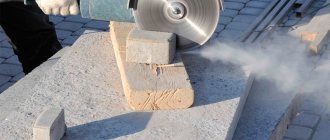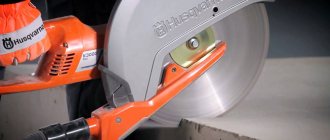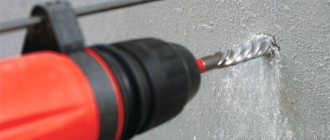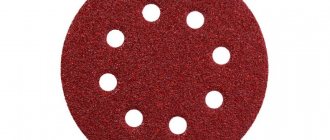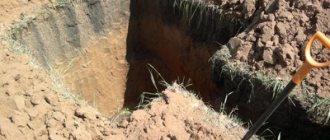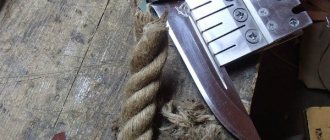The grinder is a universal tool with a wide range of capabilities. To implement them, a special attachment for the grinder is required. Among its types is a diamond cup for concrete for a grinder, which is used to clean and polish floors and walls.
What is a grinder disc for concrete?
A grinder or a manual grinder is very convenient for cutting ceramics, concrete, and brick. It is only necessary to use a special disc for a grinder on concrete, since corundum and carbide abrasives used when cutting steel or soft stone are not suitable.
To cut a concrete product, you need discs of a special design and a different composition. The cutting element in them is diamond chips, obtained artificially from carbon minerals. The price of these tools is much higher than abrasive wheels for cutting metals.
The disc is based on durable hardened steel that can withstand high temperature loads. Its cutting part is the outer edge containing a layer of diamond crumble. Such layers contain very small technical diamonds distributed throughout the volume.
When cutting, the outer layers are actuated, but the abrasive composition is actuated much more slowly than the mass being cut. After one layer has been triggered, the next one is activated, thanks to which an expensive cutting tool allows you to perform work that is much larger in volume compared to a conventional one.
Working principle of diamond cutting disc
Most diamond blades are used on angle grinders with speeds up to 12,000 rpm. The maximum number of revolutions that the best wheels can withstand is 13900 rpm, but there are not too many tools capable of developing them when cutting.
Only the diamond itself comes into contact with the surface being treated - it protrudes above the surface of the rim and, when rotated, abrades the material into fine dust. The multi-layer structure of the cutting edge ensures that the disc is always ready for work - diamonds that have worn out or flown out of the socket are replaced by others that are located in a lower layer of the rim.
Excess heat is dissipated through the disk body, but, nevertheless, it heats up to fairly high temperatures, which requires compliance with certain safety rules when dry cutting.
The durability of the wheel and the effectiveness of its use depend on the size of the diamonds. Large ones provide efficient operation, but wear out quickly, small ones cut very accurately, but more slowly, their service life is 25 - 30% longer than that of tools with large crystal fractions.
Tool functionality
Depending on the purpose, the disc for the grinder for concrete is made whole or divided into separate segments. Dividing the working surface into segments helps to increase the cooling intensity of the tool during operation. The cutting edge itself can be made from diamond chips of different grain sizes with different connecting elements. The technology of making the cutting layer also plays a role.
Methods of technological fastening of cutting segments to a steel base, as well as the corresponding functional purpose of the disks:
- soldering with silver solder, the tools are used when cutting concrete in a wet environment, due to which their surface quickly cools and does not peel off from the base;
- laser welding, which makes it possible to obtain highly reliable cutting wheels that can be used when cutting reinforced concrete structures, marble, granite without moisture;
- thermal spraying using a binding agent or geometric closure, which makes it possible to use circles for wet and dry cutting of concrete.
Depending on the dimensions of the concrete products to be cut and what models of grinders will be used, diamond discs are manufactured by industry in various diameters.
Introduction to Diamond Cutting Wheels
Wheels with diamond cutting edges for waterless cutting were first created in the design bureaus of the Japanese company Sankyo Diamond Tools, a structural division of Hitachi Corporation.
Many technologies were used for the first time, so the wheels were not reliable enough and quickly failed. For example, diamonds and the cutting part were attached to a steel base using high-temperature soldering. During operation, when a large friction force occurred, the metal heated up, the solder melted and the working part simply fell off. With water cooling, such circles worked more or less tolerably, but with dry friction their service life was short.
The fact is that diamond does not cut the material, but abrades it into dust; high frictional forces are accompanied by rapid heating - the heat does not have time to be dissipated throughout the body of the circle, in addition, despite the presence of special slots, the circle is deformed when heated. Changes in shape are insignificant and do not threaten destruction, but have a negative effect on the strength of the connection.
Sankyo Diamond engineers also proposed other solutions - sintering the working part and the base under high pressure. This connection is more durable and can withstand significantly higher temperatures. Thus, it was possible to create segmented and solid disks that are resistant to heat and deformation. The technology is still in use today.
The second solution is laser welding at the molecular level. This technology produces only segmented circles. In terms of strength and reliability, both types of discs are almost the same, although many professionals believe that those made by laser welding are better.
Types of disks, their features
The industry produces several types of diamond wheels that can be installed on an angle machine:
- with a segmented body;
- turbo diamond;
- wave in a turbo-diamond case.
Diamond wheels of these types are capable of withstanding a very large technological load, designed for cutting reinforced concrete, but the cost of such attachments is the highest. They are divided into professional and household, which is typical for most construction tools. For different operating conditions, they are produced by industry in different designs.
Standard sizes and prices
Concrete grinding disc 125 is a circle of metal onto which cutting parts (segments) are soldered . To fix the diamond powder on the segments, a special binder is used - a substance that connects the individual grains together. This bond may be ceramic, metallic or organic. The main task of the bond is to hold the diamond coating, which is subject to the centrifugal force that occurs when the tool rotates. Diffusion sintering is used to connect the diamond layer to the metal body .
The drive designation contains three parameters:
- disk diameter, mm;
- cutting width (working fluid thickness), mm:
- bore diameter, mm.
For example, the designation of the HILTI DC-D 125/22 UP disk is deciphered as follows: 125 is the diameter of the circle, 22 is the diameter of the mounting hole. In this case, the width of the cut is not specified. This means that it is minimal. Mentioning cutting width is usually a marketing ploy . The manufacturer wants to emphasize that his tool is wider and, therefore, stronger. But, in fact, this does not correspond to reality.
Criterias of choice
It can be quite difficult for non-professionals to choose the appropriate grinding tool for their current tasks. To correctly solve this problem, you need to take into account:
- type of material being processed;
- planned grinding depth;
- parameters of the disk itself: number of segments, diameter, rotation speed.
, the concrete grinding disc 125 is most often used , the price of which varies over a fairly wide range and depends mainly on the manufacturer.
Discs with a diameter of 125 are designed for the simplest and most low-power home angle grinders
Price
Approximate prices of diamond blades from different manufacturers:
| Disc diameter, mm | Manufacturer | Cost, rub |
| 115 | Luga Nova | 90-120 |
| Hilti | 280-340 | |
| Bosch | 480-620 | |
| 125 | Luga Nova | 90-195 |
| Hilti | 280-400 | |
| Bosch | 750-1200 | |
| 150 | Luga Nova | 90-220 |
| Hilti | 450-550 | |
| Bosch | 840-1200 | |
| 200 | Luga Nova | 280-350 |
| Hilti | 450-700 | |
| Bosch | 900-1400 | |
| 230 | Luga Nova | 300-400 |
| Hilti | 650-840 | |
| Bosch | 1400-2700 | |
| 250 | Luga Nova | 450-800 |
| Hilti | 1250-2900 | |
| Bosch | 3500 |
The advantage of diamond blades is their wear resistance and strength, as well as the accuracy and high quality of the cut. When using this tool, chips and burrs do not form, even when processing such a durable and porous material as concrete.
Household diamond wheels
For home purposes, a grinder disc for concrete is also often used, which can be used to cut very hard materials, ranging from ordinary bricks to ceramics and concrete tiles. But they are not very suitable for cutting granite, marble or carving a reinforced concrete base. In addition, tools for household purposes wear out so quickly that they are not used for professional purposes.
Such household diamond blades as “Zubr”, “Sparta”, “Tsentroinstrument” have optimal ratios in the price-quality segment. The external coating on them meets high requirements; with irregular use, they last quite a long time.
It is very important to use diamond wheels in accordance with their intended purpose; they should not be used to cut metal or concrete without proper cooling. To ensure that cutting wheels do not overheat and serve reliably, it is necessary to limit the duration of their switching cycles.
What is a grinder attachment in the form of a diamond cup?
To prepare for applying the next layer or final finishing of the coating, the screed is ground and polished. At the same time, uneven surfaces are removed and cracks are smoothed out. The ultra-hard working surface of the equipment - a diamond cup for concrete - easily removes the top layer.
Design Features
The nozzle has a round concave base on which a grinding wheel is attached. Its working part is divided into segments with small diamonds attached.
The bowl-like base has holes that help cool the tool during use. Between the segments there are spaces left - slots. They help cool the tool and material with air and water.
There is a hole in the center of the cup through which it is threaded through the grinder spindle and screwed with a nut. Some models have a thread in the hole, so the tool is screwed onto a shaft.
Nozzle for an angle grinder. Main characteristics
The diameter of the cups is standard: 110-180 mm, the most popular is 125 mm. The grinder engine must have a power of at least 1.5 kW. Large nozzles work faster, but they are more expensive - a more powerful machine is required. The mounting hole for use with a standard size grinder is 22.2 mm.
Small diamond fractions are fixed on a steel base. The mixture is pressed, which makes it especially strong. Mills with large grains (200/160 microns, 160/125 microns) are used for stripping and rough processing of surfaces. Finishing is carried out with diamond-coated nozzles of small and medium fractions: 125/100 microns, 100/80 microns.
Diamond grinding cups are valued for benefits such as:
- high strength;
- efficiency;
- good balance, making work easier;
- durability.
An important advantage is the ability to work without water cooling. Hot air is discharged through holes in the bowl, preventing overheating.
Nozzle for an angle grinder. Application area
Diamond cups are superior to other attachments in terms of efficiency. This is achieved by high wear resistance and reliability. They peel and polish various materials: concrete, brick, artificial and natural stone, porcelain stoneware, paving slabs.
Diamond cups perform the following operations:
- peel off the sagging screeds;
- remove irregularities;
- align the seams;
- grind the joints;
- clean surfaces;
- remove unnecessary layers;
- polished.
Sanding cups save time: they simultaneously remove deposits and level the surface.
Professional circles
For production purposes, professional diamond wheels with diameters from 125 to 350 millimeters are used. Their cost is significantly higher than the price of similar household cutting tools, but their very high wear resistance and excellent quality of abrasive coating ultimately make them more profitable for regular use.
The high price of professional discs is justified due to their high durability. Products from Distar and Bosch have excellent performance, but the price for one such circle with a transverse size of 230 mm is more than 2,600 rubles.
Classification of professional diamond blades by purpose:
- cutting reinforced concrete;
- making carvings on a concrete base;
- cutting marble, ceramics, granite massifs.
It is very important to understand that if the purpose of professional tools does not correspond to the purposes of use, they will wear out very quickly, and ultimately the costs of performing the work will increase.
Scope of application
The high reliability and wear resistance of the diamond cup make it unrivaled among other equipment for processing hard materials. Using the nozzle, you can scrape and grind concrete, brickwork, stone slabs, porcelain tiles, and paving slabs. Diamond discs are widely used for polishing natural stone - marble or granite. Operations performed using discs include rough, profiled and finishing grinding operations. Diamond cups are used for the following purposes:
- removal of screed sagging;
- roughening;
- alignment of seams;
- grinding joints;
- surface cleaning;
- removal of old or protruding layer;
- final polishing.
When installing attachments on an angle grinder, a dust extractor is usually used or the surface to be treated is moistened with water (wet grinding). This will help reduce dust and make cleaning easier.
Concrete grinding discs are widely used during dismantling work. They effectively remove layers of used glue, hard-to-remove coatings (epoxy, plaster, plaster) and have a long service life. Grinding with a diamond cup saves time: it not only removes unnecessary layers, but also immediately levels the surface.
Features of working with the tool
In order to make the most of the working life of an expensive diamond tool, you need to adhere to important rules for its operation:
- cutting reinforced concrete should be done in successive shallow passes;
- the first pass is performed to a depth not exceeding 10 mm;
- the depth of each subsequent cut should not exceed 15 mm.
Before starting work, you need to accurately determine the brand of concrete and its frame, since each material requires different types of diamond cutting tools. If the concrete is reinforced with steel rods and the thickness of the part to be cut exceeds 100 mm, a special disk must be used.
It is also taken into account whether the concrete mass is fresh or old to be cut, because over time the properties of this material change. Old concrete is always stronger than fresh concrete; cutting it requires more expensive tools. The larger the cutting wheel's heavy-duty filler, the slower the cutting needs to be.
Description and classification
A diamond disk is a metal circle of small thickness with cutting diamond plates fixed on the edges. They are made from industrial ground diamonds, which are pressed into a metallic binder - carbide, steel or titanium. The plates are attached to the disks using silver soldering or laser welding. Modern technologies connect the cutting tool to a metal base using powder soldering. This way they last longer. Once the cutting part of the diamond blade has been sharpened, it is completely ready for use.
In order to cut reinforced concrete or concrete, a variety of equipment is used, such as stationary machines, wall chasers, gas cutters, and grinders. Different brands of circles are attached to them. Their distinctive features are:
- Working edge configuration.
- Composition of the binder.
- Number of diamonds per unit area.
- Quality indicators of diamonds.
To choose the most suitable option for you, you need to familiarize yourself with the classification.
Circles are divided into groups according to several criteria. The most important indicators are: the purpose and shape of the cutting part .
Diamond cutting discs
This group is divided into three subspecies . These include:
- Segmental for dry cutting. Concrete is cut dry using hand tools. For these purposes, a grinder (angle grinder) and a wall chaser are used. On the base of the segmented circle, the diamond contour is located in the form of separate sectors, and between them there are radial through grooves. During the cutting process, the plates experience heavy loads and the discs heat up. The slots are necessary to relieve stress in the cutters, remove waste, remove heat and compensate for linear expansion. This group includes diamond tools for cutting fresh concrete. The difference between such circles is that they can be used to cut material immediately after hardening. The diamond layer is usually filled directly onto the body without using a binder.
- Infinite (whole). There are no segments on such circles. And in order to distribute the tension, there are holes. They are used when cutting is carried out with water cooling. Wet processing is carried out on stationary equipment. Such equipment has the design ability to supply coolant.
- Diamond discs for reinforced concrete. These discs have a segmented design, but the teeth contain more diamonds than a conventional disc type. They are a little thicker. It is necessary to take into account the fact that reinforced concrete is very difficult to cut at home. The grinder heats up quickly, dust penetrates inside it (to prevent dust from penetrating, dust protection for the bearings and a dust-proof motor are necessary). Using a hand-held power tool, it will be possible to cut reinforced concrete no deeper than 10 centimeters in one go. After this, the equipment will turn off to cool the disk and motor.
- Turbo segment diamond cutting wheels. They are solid, and their cooling is carried out due to the wavy surface. Their price is higher than regular circles, but they compensate for these costs with expanded functionality and a long service life. They can even cut reinforced concrete if the diameter of the reinforcement does not exceed 10 centimeters.
Diamond grinding discs
These wheels are used to grind concrete if it is necessary to level the floor before applying a decorative coating. This process is carried out with a special grinder or grinder. Grinding wheels differ in that the cutting diamond layer is applied to a conical annular surface that protrudes along the edge. A diamond disk for mechanical floor processing is a main circle on which several grinding cups are attached, between which there are grooves for removing dust.
Selecting a Diamond Wheel
To choose the right grinding wheel, you need to know about two ways to attach its segments - using silver solder or laser welding. Silver solder discs are used for wet cutting, while laser welding discs are used for dry cutting.
You also need to know exactly what the seat size of the angle grinder is. If the diameter of the mounting flange does not match the inner diameter of the circle, then it will be impossible to use it.
The working rotation frequency of the angle grinder should not exceed the same parameter indicated on the circle. The best option is when the maximum frequency indicated on the circle exceeds the operating frequency of the angle grinder.
Only knowing exactly all the listed dimensions and parameters can you choose the right cutting tool and then successfully complete the job.
Shape and number of segments
The quality of the work performed depends on the type and number of segments. There are cups for roughing, rough grinding and for fine polishing of surfaces. According to the shape of the cutters, the nozzles are classified into the following types:
- With double segment
- Square
- Boomerang
- Turbo
- Typhoon
The design of each type provides for a specific arrangement of segments, which affects its operating properties.
Double segment
The Double Segment Diamond Cup is a two-row tool for eliminating large defects in concrete products. Large beads or protruding seams can be easily sanded with this attachment with a good abrasive effect. Segments arranged in a circle in two rows quickly and efficiently process stone or sandstone. Sometimes builders use a nozzle to reduce a thick layer of screed. But with the help of the “Double Segment” it is impossible to achieve ideal smoothness; the screed becomes rough, so for finishing sanding you need to use a different attachment.
Boomerang
The tool received its name due to the similarity of the shape of the diamond segments to a boomerang. The tool is used for finishing concrete grinding, since the cutters use fine-grained diamond chips. After processing, the screed becomes perfectly smooth. The small weight of the “Boomerang” makes it easy to use; it is often installed on an angle grinder because it is light in weight. The popularity of this type of cup is due to its high productivity, which is almost twice that of other types of diamond blades. The choice of this particular tool is also influenced by its lightness and stability.
Square
Diamond cups “Square” are used for roughening concrete surfaces. The effectiveness of the tool allows it to be used to remove large sagging and protruding seams. Diamond cutters are made in the form of squares. The increased thickness of the working segments and the large distance between them make it possible not only to level the surface with roughness, but also to remove any protruding parts on the concrete. Therefore, grinding with the “Square” attachment reduces the time for rough processing of concrete and brick coatings, extending the life of the diamond segments.
Discs for grinding concrete “Square” are heavy, making it possible to process the material with the tool without much effort.
After passing through the diamond cup, the surface remains rough, which gives it high adhesive properties. This is especially important for adhesion to applied coatings, especially polymer ones.
Turbo and Typhoon
The diamond cutters of these attachments are located in a circle on the working surface perpendicular to the direction of rotation. The minimum distance between them creates an almost continuous ring. The appearance of “Turbo” and “Typhoon” disks resembles corrugated fabric. Many segments smoothly polish the surface, so the products are used for finishing grinding of concrete screeds in small areas and for shaped stone processing. Using attachments, you can chamfer and form edges, as well as polish small curves on workpieces.
To perform small operations, you can purchase “Turbo” and “Typhoon” cups of small diameter – from 100 mm. The discs are characterized by wear resistance, high productivity and precision processing.
Surface preparation
Before grinding you must:
- Dismantle the old coating;
- Cut off all large growths;
- Make sure there are no metal fittings exposed to the surface. If there is one, cut it off with a grinder;
- Check the evenness of the surface with a three-meter ruler;
- Carry out an examination of the plane for the size of cracks and seams. If they are available, sealing is carried out using any hand tool with epoxy resin-based mastic;
- The floor and walls are tapped for strength. Refill if necessary.
Repairing Potholes
Concrete wall repair
Repairing potholes when renovating a property is important. After long-term use, the concrete surface becomes covered with potholes and bumps; their difference exceeds the permissible size of 5 mm. This requires removing defects before grinding begins.
In this case:
- Using a diamond wheel placed on a grinder, the damaged area is cut to a depth of at least 200 mm, and the material is removed;
- The cavity is cleaned from dust with a sandblaster;
- Treated with primer;
- After drying, it is sealed with a special compound;
- Using a lath or rule, the repair mixture is leveled.
After the solution has hardened, you can directly grind the concrete with a circle.
Small cracks are usually opened in a circle to a depth of 100 mm. The algorithm for performing the work is identical to eliminating potholes, but it is not necessary to remove the damaged area.
Surface grinding
Grinding with a diamond wheel does not correct mistakes that were made in the preliminary stages. It only removes the weakest concrete layer and slightly trims the resulting surface.
The instructions for carrying out the work are as follows:
- You can turn on the tool only after checking its serviceability;
- The reliability of the bowl is checked;
- The operating time of the equipment is no more than 15 minutes, after which it should be turned off to cool to room temperature;
- It is necessary to take care of a special suit that protects you from the dust that is generated during grinding;
- Measures are taken to ensure timely replacement of cups when they are worn out with similar ones in order to maintain high quality of work.
https://youtube.com/watch?v=seUHW_QgMX8
For mechanical processing of screeds, it is better to use bowls with a diamond grit of at least 400.
Features of wall grinding
Grinding a wall with a diamond cup
When processing walls, it is necessary to take into account some nuances. Concrete walls cannot be sanded using equipment used for floor work. This is due to the high gravity that interferes with its operation.
When sanding walls, as shown in the photo:
- It is rational to use hand-held grinding machines with large-grain diamond bowls;
- It is better to start the processing process from any corner;
- It is most rational to carry out sanding in small strips, starting from the ceiling, moving towards the floor;
- From time to time it is necessary to check the evenness of the wall with a level, and move on to the next strip after obtaining an even vertical line on the previous one;
- If putty has been applied to the walls, do not use excessive zeal so as not to remove all of it. Otherwise, the work will need to start again.
Cleaning a repaired crack
Leveling the floor
The video in this article will tell you in detail about grinding concrete walls and floors.
https://youtube.com/watch?v=wHNhxkUe-d8
If a concrete sanding cup is used to finish the surface of walls or floors, the texture of the material looks better. At the same time, small differences in the concrete are smoothed out, and the surface acquires better qualities not only in appearance, but also in performance characteristics.
Features of choosing grinding cups
The efficiency and quality of work depends on the correct choice of diamond cup. When choosing a tool, you need to consider the following points:
- for what purpose is the tool needed? For roughing operations, a single-row concrete grinding cup 125 is suitable, and to eliminate defects in the concrete base you will need a double-row tool;
- cup size;
- mounting hole size . The diameter of the mounting hole must correspond to the diameter of the shaft of the grinding machine on which the selected tool will be installed;
- cup rotation speed . The number of revolutions of the cup must match the maximum rotation speed of the grinding equipment;
- An adapter ring must be included with the cup , which provides opportunities for using the tool on various equipment.
When working with cups, you must remember that diamond tools heat up at high speeds .
All of the above points are very important, since the number of work cycles and the productivity of the tool depend on them
This negatively affects the functional properties of the tool, regardless of whether diamond cups are used for grinding concrete, the price of which is high or not. you will need water for cooling while working with these cups .
Main characteristics
Double-row bowls are considered more productive.
To make cups, a metal alloy and small fractions of diamonds are needed. This composition must be compressed in special forms. Since this grinding equipment is used for various purposes, it differs in several ways:
- type of binder;
- crumb size;
- location and type of cutters on the cup.
In addition, discs can be double-row or single-row. Double-row ones are considered more productive. They also have a long service life. At the same time, such discs are more expensive than other models.
With the help of a nozzle, builders are able to smooth out sagging and other defects that arise when molding a cement mixture. High-quality grinding allows you to make concrete walls smooth. This results in a perfectly polished surface. Cups are often used for various construction works. For example, when dismantling formwork from structures, nozzles are indispensable for leveling seams. However, they also have other advantages. Thus, they are used for the restoration of concrete products.
In addition, high-quality grinding discs weigh little, grind the surfaces of concrete structures well, allow you to restore old products, and are considered highly productive. With proper handling, the equipment will serve you for many years. Metal circles are produced with a diameter of 150-180 millimeters. Diamond equipment can be used both for grinding surfaces and for drilling concrete.
